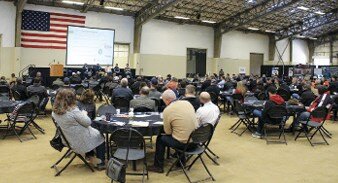Farmers discuss changes brought by technology
By Kevin Hecteman
Agricultural technology, in the popular mind, often takes the form of mechanical harvesting machines or drones tracking soil moisture or water flow.
Emery Silberman thinks of tracking money flow.
“Technology is really easy to talk about, but in my experience at the farm, I’ve recognized that some of the sexier technologies don’t necessarily provide as much benefit as some of the non-sexy technologies,” said Silberman, chief technology officer at Bowles Farming Co. in Los Banos. “We can all talk about soil sensors or irrigation automation, but I feel like no one’s talking about finances and managing your costs. A farmer that knows their costs well can make money.”
Silberman spoke at the second annual Valley Ag Tech Summit last week at Modesto Junior College. Using the theme “Adapt or Die,” the event sought to bring together farmers, producers, educators and tech professionals to discuss the many ways technology is changing farming. The event was organized by Better Food Ventures, the National Ag Science Center and Opportunity Stanislaus.
Seana Day, a partner in Better Food Ventures in Turlock, said a top focus of the conference was to bring technology into farmers’ hands as soon as possible. She was especially interested in Stanislaus County-grown commodities, among them almonds, dairy and walnuts.
“A lot of the industry talks about how you feed 9 billion people by 2050,” Day said. “That’s great for the venture capitalists; that’s great for the really aware consumer. But for growers and the producers, they need technology solutions that are ready today.”
Silberman said he thinks there could be “a huge benefit” with technology and finance.
The first step “is really implementing the farm management system, where we record everything that happens,” he said. “It can start planning and attaching costs to that, and really understanding—are we going to get into a bind with our tractors during this month if we plant on this schedule?”
Silberman said he’s working on a template based on what the farm has done in the past, then assigning costs to each activity.
“Those are the kinds of problems that could really save a lot of money, because if you get in late at the cultivation, you’ve lost a whole lot more money,” he said. “Just being smart about operations through technology can provide huge benefits.”
One such project, he noted, involves understanding the energy bill.
“That’s complicated,” Silberman said, “and they charge us a lot of money. And if you’re not smart about when you turn on the pump and how much you turn it on, you can get way overcharged without knowing it.”
An online poll conducted at the conference found workforce and labor issues topped many attendees’ list of concerns, dovetailing with a major theme of the conference—how to train and hire young people.
“We need to start connecting industry and education so that we have a next-generation workforce that comes out with what industry is looking for,” said Emily Lawrence, executive director of the Modesto-based National Ag Science Center, noting that many students in the area are unaware of career opportunities in agriculture unless they’re already connected with farming.
“They’re thinking they need to go to the Bay Area,” Lawrence said. “They’re thinking they need to go to these big tech companies, and not really making that connection that all of those tech opportunities are in agriculture right now, especially in this area.”
Day said organizers were “super-intentional about including academic institutions and academic leadership in this event, because we thought it was really important for them to understand where the private sector is going.”
Rob Steves, an educator at Joseph Gregori High School in Modesto who also farms a small almond orchard, said he was looking at switching his orchard from flood irrigation to microsprinklers and wanted to learn more about water-monitoring systems. But the initial outlay was daunting.
“At what point is it cost-effective to make these commitments financially? Is it going to pay out at the end?” Steves said. “It was good to listen to see at what point a small farmer like me can make that financial commitment.”
At Gregori High, he helps connect students with agricultural job opportunities through the school’s work experience program.
“We found a lot of these kids are interested in these ag-related jobs,” Steves said. “So we vet them through our ag program.”
He said the school has built relationships with several manufacturers of harvesting and processing equipment.
“We’re going to make sure that we’re sending them a good kid that shows up on time and has a good work ethic,” Steves said.
Many of his students take agricultural classes all the way through high school, ending with structural welding.
“Instead of taking classes after lunch, they actually go to the work site that is now their classroom,” Steves said, noting that students build skills and reputations that could someday lead to job offers.
Day said it’s critical to show academic leaders what they need to be thinking about and how to be more nimble and responsive.
“All of these things need skills that we’re going to have to have operators for the next generation be able to run these technologies,” she said, “so that skills readiness is so important.”
“It’s not your grandfather’s way of farming,” Day said. “It’s really changing.”
(Kevin Hecteman is an assistant editor of Ag Alert. He may be contacted at [email protected].)
Permission for use is granted, however, credit must be made to the California Farm Bureau Federation when reprinting this item.
